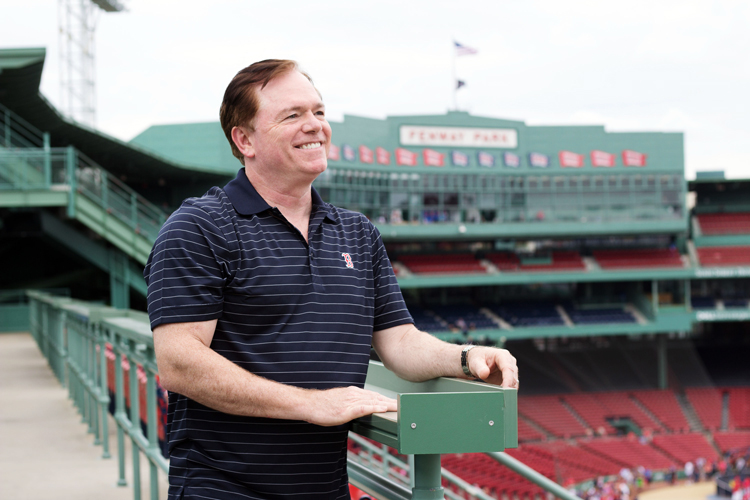Brian Shield got a firsthand lesson on how his hobby, technology, can profoundly transform a business when he was in college—and he has been a tech-driven growth catalyst for his employers ever since.
Today, Shield implements state-of-the-art technology to maintain Boston Red Sox’s position as a leader in baseball and in business, helping to drive business growth with one of the largest and most passionate fan bases in professional sports. “We’re doing creative things on premise and in the cloud that will allow us to remain highly competitive for a long, long time,” says Shield, vice president of information technology for the Red Sox.
Yet in the mid-’80s, Shield was an economics/finance major at Bentley College with a part-time job at an investment company. Using an old Apple IIe, he wrote software that automated the company’s financial portfolios. It was all fun and games to Shield until he had a lunch meeting with a portfolio manager, who asked Shield what he was getting paid.
“He said, ‘I’m not telling you you’re not getting a fair shake here, but before you arrived we had a limited number of clients because we couldn’t update our system fast enough,’” Shield recalls. “‘Now, we update the system every night, and we’ve literally tripled our business.’”
The portfolio manager suggested Shield have another talk with the CEO. Shield had an alternative plan. He switched his major, graduated with a bachelor’s degree in computer information systems, and promptly went to work leveraging new technologies to drive growth in a number of different industries, including financial services, retail, media, hi-tech, and ultimately sports.

“I’ve never been one to define myself based on the industry I work in,” Shield says. “It’s much more about problem-solving, growing the business, and identifying opportunities where technology can be an enabler and make a difference at a company.” Now as the IT leader for the Major League Baseball team established in 1901, Shield is ensuring the 117-year-old organization’s legacy is ahead of the game well into the next century.
Prior to the Red Sox, Shield spent almost fourteen years as executive vice president and CIO at The Weather Channel in Atlanta, where his positive impact is still evident. When Shield joined the network in 1998, it had just launched weather.com, but the company’s technology awareness was so nascent and the dot-com space was so early-stage that the site lacked the defensive protection of a firewall. One of Shield’s first tasks was convincing the CEO of the importance of safeguarding what would soon become a top twenty website.
Reflecting back on that moment, Shield says he is amazed at how much The Weather Channel evolved from the family-owned television network it was to a tech company owned by Baine, Blackstone, and NBC to today with its data and digital assets a part of IBM and its network assets part of Byron Allen’s Entertainment Studios.
“You can do a lot of interesting technology-related work in your career, but it’s very rare to help influence the evolution of a company’s culture,” Shield says.
That evolution began when Shield discovered upon his arrival that, with all the forecasting data the channel had generated over the years, almost none of it had been saved and curated. He immediately changed that, and today that historical data is the bedrock the fuels IBM Watson’s weather.
Shield used that experience to help the Red Sox advance its status as a sports industry innovator. There isn’t a decision today made by analysts, scouts, and decision-makers that isn’t based on data generated by technology. However, the IT leader says, “equally impactful tech-driven changes are happening on the business side with fan engagement and emerging technology.”
“When I joined the Red Sox in 2013, we were just coming off ten straight years of sellouts,” Shield says. “Leadership knew going into the 2013 season that the sellout streak was coming to an end. It was a reality check for the organization.”
At that time, the organization had done relatively little to capture and leverage fan-related data. It became a strategic imperative to change that and mirror the years of success data has brought to the baseball operations organization.
“It’s more than learning about just the traditional fans who come to baseball games,” Shield says. “It’s also understanding the habits of attendees who enjoy the many non-baseball events held at Fenway Park. Whether it is the more than 300,000 fans who come for tours, or attendees who enjoy concerts, hockey games, football games, hurling matches, or other festivities, the goal is to understand all of our fans and to create the fan amenities that seamlessly complement that action on the field and keep fans returning to Fenway Park.
“It’s a goal for the organization to understand all fans and get our arms around all those people who take advantage of what the Boston Red Sox and Fenway Park have to offer here.”
Customer relationship management (CRM) data is now the lifeblood of a number of key sales areas, providing a window into how best to service fans. “While CRM continues to evolve and provide insights into our fans, emerging technology will enable new and more engaging services that Fenway Park can offer, and provide insights into how to touch our fan base in more compelling ways,” Shield says. “Whether it is IoT, AR, VR, Wi-Fi, 5G cellular services, mobile technology, or other forms of digital technology, the technology teams aggressively look for opportunities to create a digitally rich fan experience. Through all this technology, we’re learning more about how people pass through Fenway Park, so we can seamlessly engage with fans of all ages.”
Shield and his department collaborate with outside partners as well to bring the best solutions to the team. “In working with Brian on developing new applications and analytics to bring substantive advantages to the Red Sox, we found great alignment in looking outside of baseball for new ways of thinking,” says Russell Norris, general manager at consulting firm Slalom. “His understanding of the challenges the organization was having with new concepts enabled us to put together a successful approach for his teams.”
The bottom line to everything Shield is doing is the same as it’s been everywhere else: innovate and grow. He is focused on ensuring that the technology is a differentiator for his employer. And now with the Red Sox, he may be having the most fun doing that since writing software on that old Apple IIe.
“We are right in the center of the bull’s-eye as far as the ability to leverage data and technology in a positive way to benefit our fans,” Shield says. “Ideally, we hope to create a frictionless experience for fans where they can enjoy the amenities of Fenway Park, without technology becoming a distraction or taking away from the experience on the field. I’m optimistic that combining emerging technology with a deeply loyal fan base [Red Sox Nation] affords us the opportunity to create a unique fan experience well into the future.”

